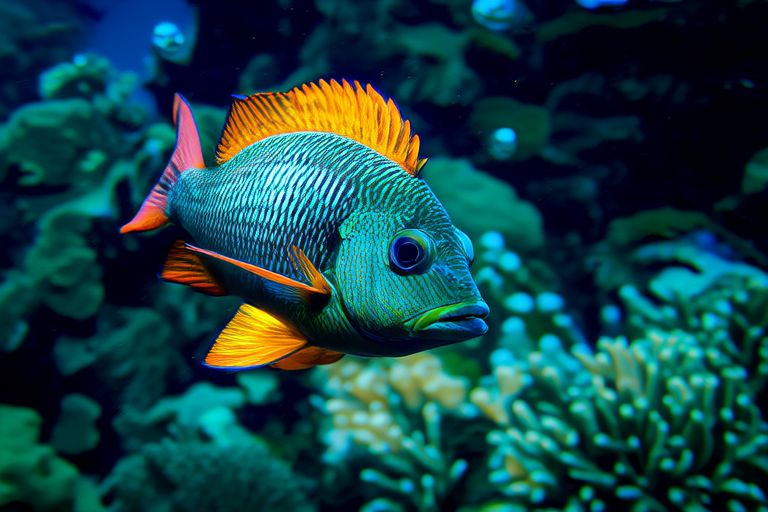Parrot Fish: A Dive into Vibrant Marine Life
Parrot fish, with their dazzling colors and intriguing behaviors, are some of the most captivating creatures in the world’s tropical oceans. These fish are not only visually stunning but also play a crucial role in maintaining the health of coral reefs. From their vibrant hues to their nocturnal transformations, parrot fish offer a fascinating glimpse into the rich biodiversity of marine ecosystems.
Vibrant Colors and Camouflage
One of the most striking features of parrot fish is their vibrant coloration. These fish come in a wide array of colors, including shades of blue, green, yellow, red, and purple. Their colors serve several purposes, including camouflage, communication, and attracting mates. The vibrant hues help them blend into their surroundings, making it easier for them to avoid predators. However, during mating season, parrot fish often display even more intense colors, signaling their readiness to reproduce.
Interestingly, some species of parrot fish undergo dramatic color changes as they age or when they transition from male to female. This phenomenon, known as protogynous hermaphroditism, is common among many species of parrot fish. In this process, young individuals start as females and, under certain conditions, can transform into males later in life. This unique adaptation allows for efficient population dynamics within the species.
Nocturnal Transformations
Another remarkable aspect of parrot fish is their ability to change appearance at night. While they are typically brightly colored during the day, some species of parrot fish become much duller at night. This transformation helps them blend into their surroundings and avoid detection by nocturnal predators. Scientists believe that this color change is linked to the release of hormones that alter the pigmentation of their skin cells. This nightly transformation underscores the adaptability of these fish and their sophisticated survival strategies.
Feeding Habits and Coral Reef Maintenance
Parrot fish have a unique diet that contributes significantly to the health of coral reefs. They primarily feed on algae, which they scrape off coral surfaces using their strong beaks. This feeding behavior, known as herbivory, plays a vital role in preventing algae overgrowth, which can smother and kill corals. By keeping algae in check, parrot fish help maintain the delicate balance of coral reef ecosystems, ensuring that corals have enough space and nutrients to thrive.
After consuming algae, parrot fish excrete fine sand particles. This process, known as bioerosion, contributes to the formation of sandy beaches and helps maintain the structural integrity of coral reefs. In fact, it is estimated that a single large parrot fish can produce up to 90 kilograms of sand per year. This contribution to beach formation highlights the integral role that parrot fish play in shaping marine environments.
Mating Rituals and Reproduction
The mating rituals of parrot fish are as colorful and complex as their appearance. During the breeding season, male parrot fish engage in elaborate courtship displays, showcasing their vibrant colors and performing intricate dances to attract females. Once a pair has formed, they often swim together in a circular pattern, releasing clouds of eggs and sperm into the water. This mass spawning event increases the chances of fertilization and ensures genetic diversity within the population.
After mating, the female parrot fish lays thousands of eggs, which float near the surface of the water. These eggs are vulnerable to predation, so they are often guarded by the male until they hatch. Once hatched, the larvae drift through the water column before settling on the reef and joining the adult population. The survival of these larvae is critical for the continuation of the species, and parrot fish have developed various strategies to increase their chances of successful reproduction.
Threats and Conservation Efforts
Despite their importance to marine ecosystems, parrot fish face numerous threats, including overfishing, habitat destruction, and climate change. Many species of parrot fish are highly valued for their meat and vibrant colors, leading to unsustainable fishing practices in some regions. Additionally, the degradation of coral reefs due to pollution, coastal development, and rising ocean temperatures further exacerbates the challenges faced by these fish.
To address these issues, conservation efforts are underway to protect parrot fish populations and their habitats. Marine protected areas (MPAs) have been established in many parts of the world to safeguard critical reef ecosystems and provide safe havens for parrot fish and other marine species. Furthermore, sustainable fishing practices, such as catch limits and size restrictions, are being implemented to ensure the long-term viability of parrot fish populations.
Conclusion
Parrot fish are truly remarkable creatures that add vibrancy and vitality to the world’s tropical oceans. With their colorful appearances, nocturnal transformations, and essential roles in coral reef maintenance, these fish offer a captivating glimpse into the wonders of marine life. As we continue to explore and appreciate the beauty of parrot fish, it is important to recognize the need for conservation efforts to protect these valuable species and the ecosystems they inhabit.
By understanding the unique behaviors and characteristics of parrot fish, we can deepen our appreciation for the complexity and diversity of marine ecosystems. Whether you’re an aquarium enthusiast or simply curious about the underwater world, parrot fish offer endless fascination and inspiration. Let us strive to protect these incredible creatures and the environments they call home, ensuring that future generations can marvel at the splendor of parrot fish in their natural habitats.
